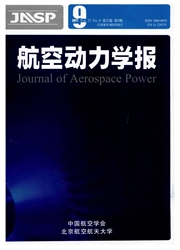

 中文摘要:
中文摘要:
使用间断Galerkin方法研究叶型转捩流动,进行了大涡模拟(LES)和转捩模型的求解,对T106低压透平和Zierke-Deutsch压气机叶栅内的流动进行了计算.通过T106低压透平的计算对LES和转捩模型进行了比较,结果表明两种方法得到的压力分布和分离泡位置均与实验值吻合良好.LES得到的分离泡的轴向位置为0.145~0.165m,转捩模型得到的分离泡的轴向位置为0.150~0.156m.LES可以再现复杂的瞬时流动细节,对于深入研究流动机理很有意义,而转捩模型尽管无法获得足够的流动细节,但是也能预测边界层的分离和转捩现象,并且结果与LES时均结果相差不大,对于工程应用很有价值.使用转捩模型计算Zierke-Deutsch压气机叶栅内的流动也获得了与实验值符合的结果.
 英文摘要:
英文摘要:
Large eddy simulation(LES) and a correlation-based transition model were applied with discontinuous Galerkin method(DGM) to investigate transitional flow on turbomachine blade.The methodology was used to simulate the flowfield within T106 turbine cascade and Zierke-Deutsch compressor cascade.Comparison was made between the results of transition model and LES for T106 cascade.The pressure distribution and the locations of separation bubbles calculated by the transition model and LES both agreed well with experimental results.The axial locations of separation bubbles predicted by LES and the transition model are 0.145~0.165 m and 0.150~0.168 m,respectively.The complex flow details,including the vortex structures in the separation bubble and the dynamic process of laminar separation,vortex shedding and wake diffusion,were simulated by LES,which can help to understand the transition mechanism.As for the transition model,although less flow details were captured,the calculated pressure distribution and the location of separation bubble agreed well with experimental data and LES results.The advantage of the transition model lies in the low computational costs,and it is more suitable for engineering applications.The accuracy of the transition model was further validated by the calculation of Zierke-Deutsch compressor cascade.
 同期刊论文项目
同期刊论文项目
 同项目期刊论文
同项目期刊论文
 期刊信息
期刊信息
